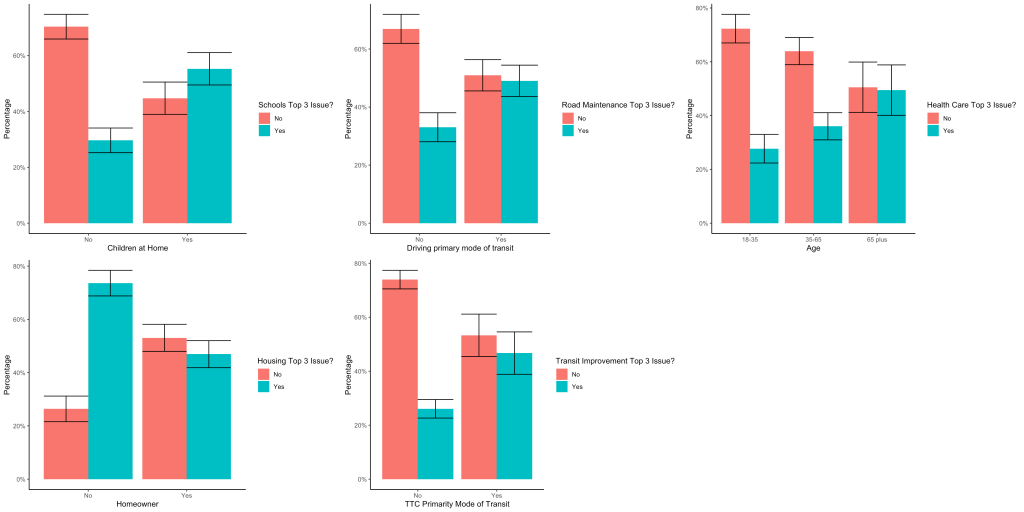Place and personal experience drive local priorities and perceptions
What factors explain why some individuals prioritise some dimensions of neighbourhoods over others? Surprisingly, people who live very close to one another are not especially likely to share similar neighbourhood priorities. For example, neighbours often had very different perceptions about how many local amenities were available in their neighbourhoods and about how safe their neighbourhoods are. In general, people who live on the same block and walk the same streets may very well experience the same space in different ways. Similarly, as we saw in the conjoint experiment, views about ideal neighbourhood characteristics were largely similar in both our lower and higher income areas.
If geography does not directly account for residents’ priorities, what does? In fact, they follow patterns that our research identified. A critical basis of policy priorities is personal experience. Generally, residents prioritise issues that are relevant to their own concerns. The figure to the right makes this clear.
These figures show the percentage of various sub-groups of residents who considered multiple policy areas to be among their top 3 priorities. For example, the figure on the upper left shows that around 70% of those without children at home do not consider schools to be a top priority, whereas a majority of those with children at home do rate schools as a top priority
We examined the proportions of respondents who ranked various policy areas among their top 3 in importance. We compare, for example, how likely home-owners and non-home owners are to prioritize reducing housing costs. The differences are striking: over 70% of non-homeowners rated reducing housing costs as a high priority, compared to about 45% of homeowners; residents with children at home were much more likely to prioritise improving local schools than residents without children at home (over 50% vs. 30%); drivers tended to prioritise road maintenance, while transit users were more likely to prioritise improving transit; older individuals rated health care as a more important priority than did younger people. In general, there are clear linkages between residents policy priorities and their personal situations. Local policy is not an abstract question of ideology for our respondents but flows directly from concrete experience and a desire to improve quality of life.
 Nevertheless, these linkages between personal experience and policy priority are not always straightforward. Consider again housing costs. While homeowners are less likely to prioritise reducing housing costs compared to non-homeowners, nearly 50% of homeowners still placed reducing housing costs among their top 3 most important issues. Personal experience and interest can extend widely, including beyond the individual self. Thus, if we probe deeper we find some patterns here as well. For example, if we examine which homeowners tend to support reducing housing costs, we find that wealthier individuals who live in lower income neighbourhoods are substantially more likely to do so than wealthy individuals in higher income neighbourhoods, even when we control for a battery of other variables. While we cannot give a definitive interpretation of this result, it is intriguing; it indicates that wealthier persons living in more economically mixed communities can develop different outlooks compared to those who live in more economically segregated areas, and in particular may be more likely to support policies that can help their lower income neighbours.
Nevertheless, these linkages between personal experience and policy priority are not always straightforward. Consider again housing costs. While homeowners are less likely to prioritise reducing housing costs compared to non-homeowners, nearly 50% of homeowners still placed reducing housing costs among their top 3 most important issues. Personal experience and interest can extend widely, including beyond the individual self. Thus, if we probe deeper we find some patterns here as well. For example, if we examine which homeowners tend to support reducing housing costs, we find that wealthier individuals who live in lower income neighbourhoods are substantially more likely to do so than wealthy individuals in higher income neighbourhoods, even when we control for a battery of other variables. While we cannot give a definitive interpretation of this result, it is intriguing; it indicates that wealthier persons living in more economically mixed communities can develop different outlooks compared to those who live in more economically segregated areas, and in particular may be more likely to support policies that can help their lower income neighbours.
This figure shows results of a multiple regression analysis examining the impact of respondent income on their probability of rating housing costs as a top policy priority, controlling for a number of other variables.






